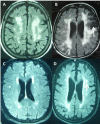Daily Living Activities and Cognition in Aged Patients: Effect of Acute Systemic Diseases and Stroke on Leukoaraiosis
- PMID: 30338749
- PMCID: PMC6388423
- DOI: 10.2174/1874609811666181019103642
Daily Living Activities and Cognition in Aged Patients: Effect of Acute Systemic Diseases and Stroke on Leukoaraiosis
Abstract
Background: Acute Systemic Diseases (ASD) impact on extended leukoaraiosis (ExLA) have been seldom described. We study the deterioration in daily life activities (DLA) and cognition associated with ASD events compared with the well-described impacts of stroke in patients with leukoaraiosis (L-A).
Methods: Cross-sectional surveys of aged adults from the emergency room after an acute event of ASD or stroke, hospitalized or receiving home care, were followed for one year. From 268 initial patients 206 were included in the study, all with moderate to severe L-A (Fazekas 2 and 3). The Clinical Deterioration Rating (CDR) and the modified Rankin scale with structured interview were obtained one week previous to admission and after 3 and 12 months of evolution. Comparisons were conducted within and between groups with nonparametric techniques.
Results: We formed three groups of similar age, A: Inpatients with one Stroke, B: Inpatients with one ASD, and C: Outpatients with one ASD. A sudden deterioration in Rankin was evident in Group A, while in B and C impairment was progressive. Impairment in CDR was smooth in all groups while in Rankin it was always greater than in cognition (CDR). No differences were found in the associations between groups and risk factors, hypertension being the most frequent one.
Conclusion: ASD in ExL-A causes a worsening of DLA and cognition similar to that observed in ExL-A with concomitant stroke indicating the need, in ageing patients, of differential diagnosis in order to achieve the best possible treatment.
Keywords: Leukoaraiosis; activities of daily living; acute systemic diseases; brain small vessel disease; cognition; stroke..
Copyright© Bentham Science Publishers; For any queries, please email at epub@benthamscience.net.
Figures


Similar articles
-
Leukoaraiosis Predicts Short-term Cognitive But not Motor Recovery in Ischemic Stroke Patients During Rehabilitation.J Stroke Cerebrovasc Dis. 2019 Jun;28(6):1597-1603. doi: 10.1016/j.jstrokecerebrovasdis.2019.02.037. Epub 2019 Mar 30. J Stroke Cerebrovasc Dis. 2019. PMID: 30940427 Free PMC article.
-
Leukoaraiosis Burden Significantly Modulates the Association Between Infarct Volume and National Institutes of Health Stroke Scale in Ischemic Stroke.Stroke. 2015 Jul;46(7):1857-63. doi: 10.1161/STROKEAHA.115.009258. Epub 2015 May 21. Stroke. 2015. PMID: 25999386
-
The Clinical Characteristics of Patients with Pre-Existing Leukoaraiosis Compared to Those Without Leukoaraiosis in Acute Ischemic Stroke.J Stroke Cerebrovasc Dis. 2021 Sep;30(9):105956. doi: 10.1016/j.jstrokecerebrovasdis.2021.105956. Epub 2021 Jun 30. J Stroke Cerebrovasc Dis. 2021. PMID: 34217070
-
2001–2011: a decade of the LADIS (Leukoaraiosis And DISability) Study: what have we learned about white matter changes and small-vessel disease?Cerebrovasc Dis. 2011;32(6):577-88. doi: 10.1159/000334498. Cerebrovasc Dis. 2011. PMID: 22279631 Review.
-
Impact of cerebral white matter changes on functionality in older adults: An overview of the LADIS Study results and future directions.Geriatr Gerontol Int. 2015 Dec;15 Suppl 1:10-6. doi: 10.1111/ggi.12665. Geriatr Gerontol Int. 2015. PMID: 26671152 Review.
References
-
- Hachinski V.C., Potter P., Merskey H. Leukoaraiosis. Arch. Neurol. 1987;44:21–23. - PubMed
-
- Basile A.M., Pantoni L., Pracucci G., et al. LADIS Study Group Age, hypertension, and lacunar stroke are the major determinants of the severity of age-related white matter changes: The LADIS (Leukoaraiosis and Disability in the Elderly Study). Cerebrovasc. Dis. 2006;21:315–332. - PubMed
-
- Kuller L.H., Longstreth W.T., Jr, Arnold A.M., et al. Cardiovascular Health Study Collaborative Research Group White matter hyperintensity on cranial magnetic resonance imaging: A predictor of stroke. Stroke. 2004;35:1821–1825. - PubMed
Publication types
MeSH terms
LinkOut - more resources
Full Text Sources
Medical

